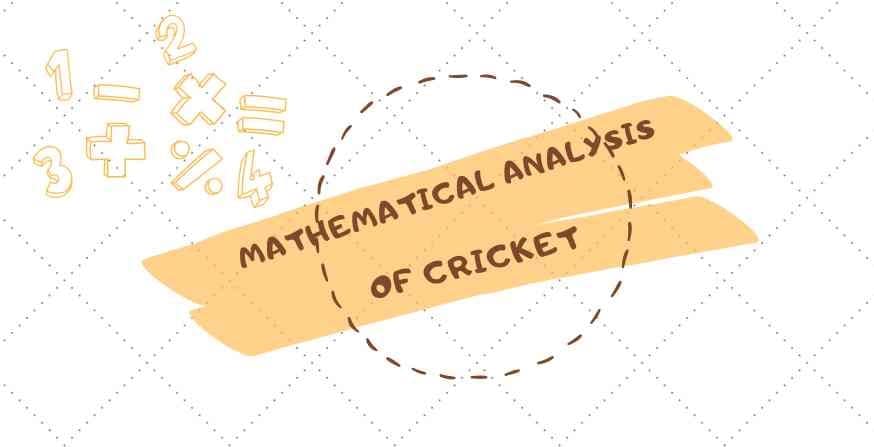Mathematical Analysis of Cricket with a Comparison
Betting on sports like cricket and engaging in slots gaming are popular activities that involve significant mathematical considerations. This article explores the underlying mathematics, focusing on probability theory, statistical analysis, and expected value calculations. By understanding these concepts, bettors can make more informed decisions and potentially improve their outcomes.

1. Probability Theory in Cricket Betting
Cricket betting involves predicting outcomes of matches, player performances, and other events. The key mathematical tool here is probability theory, which quantifies the likelihood of various outcomes.
Example: Probability of Winning a Match
Consider a cricket match between Team A and Team B. Let pAp_ApA and pBp_BpB represent the probabilities of Team A and Team B winning, respectively. The sum of these probabilities must equal 1, assuming no possibility of a draw:
pA+pB=1p_A + p_B = 1pA+pB=1
If historical data suggests that Team A has a 60% chance of winning, then:
pA=0.60p_A = 0.60pA=0.60 pB=1−pA=0.40p_B = 1 – p_A = 0.40pB=1−pA=0.40
Betting Odds
Bookmakers offer odds based on these probabilities, typically using the formula:
Odds=1p\text{Odds} = \frac{1}{p}Odds=p1
Where ppp is the probability of an outcome. For Team A:
OddsA=10.60=1.67\text{Odds}_A = \frac{1}{0.60} = 1.67OddsA=0.601=1.67
For Team B:
OddsB=10.40=2.50\text{Odds}_B = \frac{1}{0.40} = 2.50OddsB=0.401=2.50
These odds indicate the potential return on a bet. For example, a $100 bet on Team A at odds of 1.67 would yield:
Winnings=100×1.67=167\text{Winnings} = 100 \times 1.67 = 167Winnings=100×1.67=167
2. Expected Value (EV) in Cricket Betting
Expected Value (EV) is crucial in assessing the long-term potential of a bet. It is calculated by multiplying the potential outcomes by their probabilities and summing them up.
Formula:
EV=∑(P(x)×V(x))EV = \sum (P(x) \times V(x))EV=∑(P(x)×V(x))
Where P(x)P(x)P(x) is the probability of outcome xxx, and V(x)V(x)V(x) is the value (payout) associated with xxx.
Example: Betting on Team A
- Probability of winning (pAp_ApA) = 0.60
- Probability of losing (pBp_BpB) = 0.40
- Bet amount = $100
- Winnings if win = $67 (from odds calculation)
- Loss if lose = -$100
Calculating EV:
EV=(0.60×67)+(0.40×(−100))=40.2−40=0.2EV = (0.60 \times 67) + (0.40 \times (-100)) = 40.2 – 40 = 0.2EV=(0.60×67)+(0.40×(−100))=40.2−40=0.2
A positive EV indicates a potentially profitable bet over the long term.
3. Mathematical Analysis of Slots Gaming
Slots gaming, a popular casino activity, relies heavily on probability and randomness. The key factors include the number of reels, symbols, and the payout structure.
Probability of Winning
Assume a slot machine has 3 reels, each with 10 symbols. The probability of landing a specific symbol on one reel is:
p=110p = \frac{1}{10}p=101
For three reels, the probability of hitting a specific combination (e.g., three cherries) is:
pcomb=(110)3=11000p_{\text{comb}} = \left(\frac{1}{10}\right)^3 = \frac{1}{1000}pcomb=(101)3=10001
Expected Value in Slots
The EV in slots is calculated similarly to betting, but involves the paytable and probabilities of each winning combination.
Example: Simplified Slot Machine
- Winning combination probability (pwinp_{\text{win}}pwin) = 0.001
- Payout for winning = $1000
- Cost per spin = $1
EV=(0.001×1000)+(0.999×−1)EV = (0.001 \times 1000) + (0.999 \times -1)EV=(0.001×1000)+(0.999×−1)
EV=1−0.999=−0.999EV = 1 – 0.999 = -0.999EV=1−0.999=−0.999
A negative EV indicates that, on average, players will lose money over time.
4. The Law of Large Numbers and Variance
Both cricket betting and slots gaming are subject to the Law of Large Numbers, which states that the average of the results obtained from a large number of trials should be close to the expected value. This law is crucial in understanding why casinos and bookmakers generally profit in the long run.
Variance
Variance measures the spread of outcomes around the expected value. In gambling, higher variance means larger swings in a player’s bankroll.
Variance Formula:
σ2=∑(P(x)×(x−EV)2)\sigma^2 = \sum (P(x) \times (x – EV)^2)σ2=∑(P(x)×(x−EV)2)
Where σ2\sigma^2σ2 is the variance, xxx are possible outcomes, and EVEVEV is the expected value.
Example: Slots Variance
For the slot machine example:
- Probability of winning = 0.001, Payout = $1000
- Probability of losing = 0.999, Loss = -$1
σ2=(0.001×(1000−(−0.999))2)+(0.999×(−1−(−0.999))2)\sigma^2 = (0.001 \times (1000 – (-0.999))^2) + (0.999 \times (-1 – (-0.999))^2)σ2=(0.001×(1000−(−0.999))2)+(0.999×(−1−(−0.999))2)
σ2≈(0.001×1000000)+(0.999×0.000001)\sigma^2 \approx (0.001 \times 1000000) + (0.999 \times 0.000001)σ2≈(0.001×1000000)+(0.999×0.000001)
σ2≈1000+0.000999=1000.000999\sigma^2 \approx 1000 + 0.000999 = 1000.000999σ2≈1000+0.000999=1000.000999
Let’s summarise it
Understanding the mathematics behind betting on cricket and slots gaming is essential for making informed decisions. Probability theory, expected value, and variance are key concepts that can help bettors assess risks and potential rewards. However, it’s crucial to recognize that while mathematics can provide insights, the inherent randomness in these activities means that outcomes can never be guaranteed. Responsible betting and understanding the risks are always advised.
Source: BrainGym, Spilleautomater Gratis
